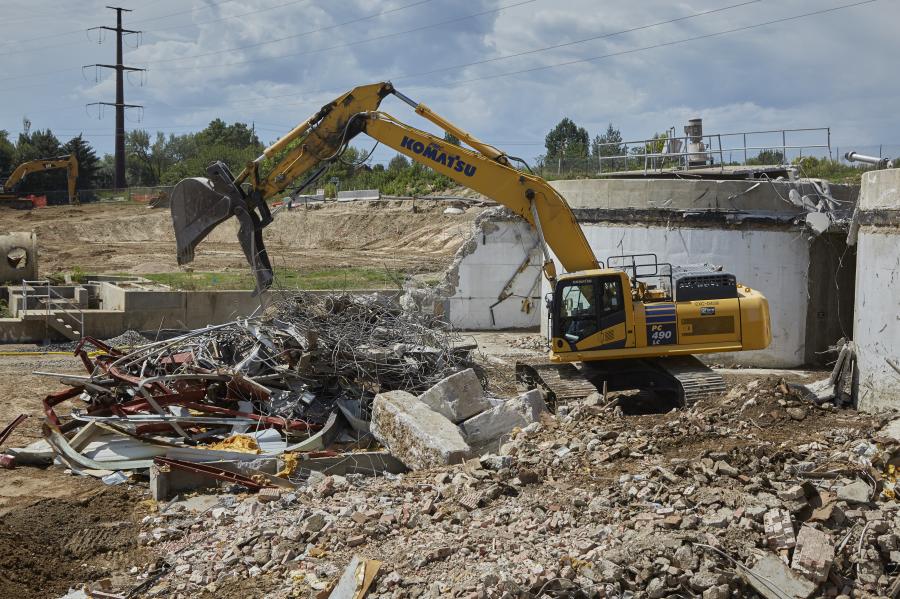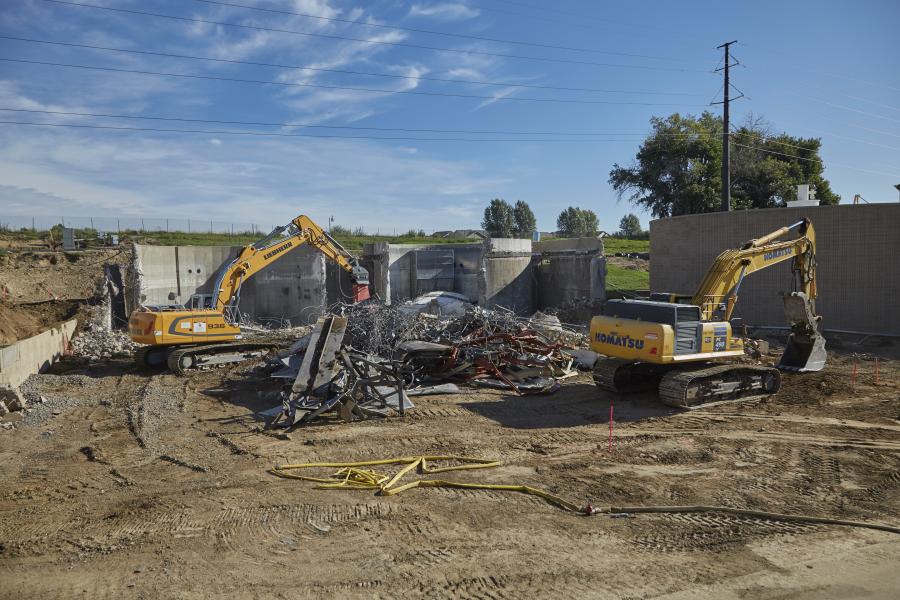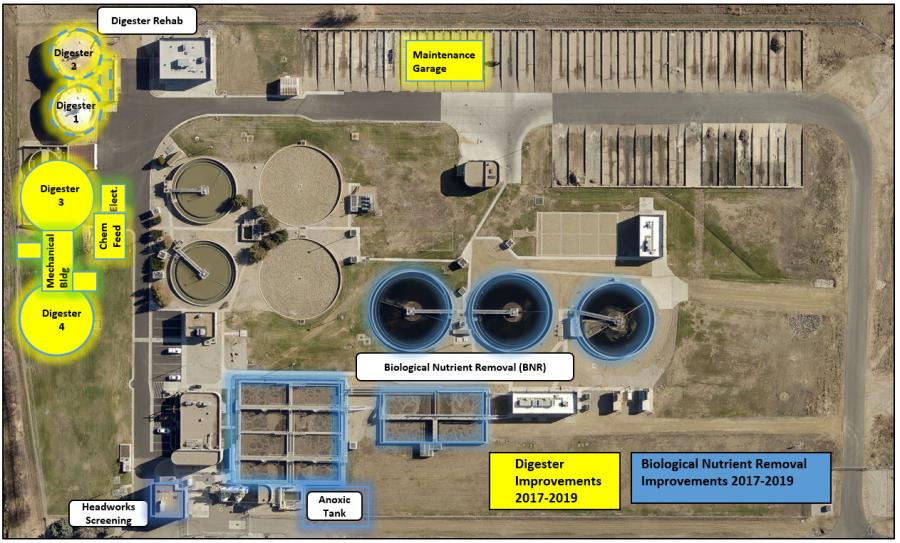The project is currently on time and at budget. Funding for the project is through Wastewater Enterprise Bonds.
(Eckstine Electric Co. photo)
Population growth and a need for modernization has necessitated a $34.5M expansion of the wastewater treatment plant in Loveland, Colo. The expansion also uses more modern techniques and water clarification devices to make the plant more efficient. That also helps in the expansion process.
Known as the Wastewater Treatment Plant Expansion Project, crews will expand the capacity of the wastewater treatment plant located at 920 Boise Ave. The work will be done in partnership with general contractor Garney Construction based in Kansas City, Mo.
Loveland Water and Power is in charge of the project and work is expected to be completed in September 2019. The project is currently on time and at budget. Funding for the project is through Wastewater Enterprise Bonds.
Major components of the project include a larger filter building, a chemical storage building, modifications to the existing flocculation and sedimentation basins, a sand filter drying bed, a soda ash feed system and secondary electrical improvements.
Population Is Growing
Growth in the area has been significant.
"Northern Colorado is one of the nation's fastest growing regions with population increasing at 2.5 percent annually, rising to 3 percent by 2020," said Tom Hacker, city of Loveland public information officer.
Also, the existing plant is aging and needs and upgrade.
"Population growth is one of the three main drivers for this project," said Brian Gandy, project manager. "The other two include meeting the new CDPHE [Colorado Department of Public Health and Environment] regulation 85 with regards to the lower effluent limits for nitrogen and phosphorus by 2020. It's the combination of all three of these that triggered the need for the expansion."
 Garney Construction is busy with numerous plant improvements. The company is known for its water and wastewater systems construction. It credits its growth to successful employee-owners. The firm has built other major wastewater treatment plants including a 45M Wakarusa Wastewater Treatment Plant & Conveyance Corridor in Lawrence, Kan.
Garney Construction is busy with numerous plant improvements. The company is known for its water and wastewater systems construction. It credits its growth to successful employee-owners. The firm has built other major wastewater treatment plants including a 45M Wakarusa Wastewater Treatment Plant & Conveyance Corridor in Lawrence, Kan.
Heavy equipment at the construction site includes, cranes, delivery trucks, cement mixers and forklifts.
Plant changes at the Loveland plant include:
- Meeting increased regulatory requirements: In accordance with new state permit limits, the plant effluent to the Big Thompson River must meet very low limits for phosphorus and nitrogen by 2020.
- Boosting capacity to meet population growth: When all work is complete, the wastewater treatment plant will be re-rated from 10 million gal. per day (MGD) to 12 MGD, allowing for an additional 10 to 15 years of growth for Loveland residents.
- Replacing aging infrastructure: Includes renovation of the existing secondary clarifiers, improvements to the existing anaerobic digesters and replacement of the head-works screening equipment.
Construction is being done in two packages. The first package included:
- Demolition of the abandoned digesters and maintenance garage;
- various water and sewer line relocations;
- construction of the new maintenance garage;
- rehabilitation of all three secondary clarifiers;
- excavation for the new digester facility; and
- demolition of the east sludge drying beds.
The second package, now under way, includes:
- Improvements to the existing aeration basins for the addition of the biological nutrient removal (BNR) process;
- headworks screening improvements;
- construction of the new digester facility and supporting infrastructure;
- construction of an anoxic tank to aid in the BNR process; and
- construction of a new electrical building.
Current work on the project includes RAS (returned active sludge) anoxic zone mechanical and electrical installations, digester yard piping and Aeration basin 1 mechanical and electrical improvements. Crews have completed the Aeration lift pump station (ALPS) electrical improvements and motor control center-6 replacement,
Ferric-MCC building masonry walls, digester mechanical and boiler room masonry walls and digester mechanical and boiler room structural deck.
Construction continues on the anoxic tank and on the digesters 3 and 4 mechanical building.
Materials
Four different pipe materials are available for wastewater collection systems, each with a unique characteristic used in different conditions. They are ductile iron, concrete, plastic, and vitrified clay.
 Overall, wastewater treatment plants like the one being expanded in Loveland make heavy use of concrete, steel and plastic. Component parts for clarifiers alone include chain, sprockets, shafts, wall brackets, peak cap, pillow block and wall bearings, flights and assemblies, wear shoes, wear strips, drive units and assemblies, scum skimmers and pipe, baffles and stainless-steel hardware.
Overall, wastewater treatment plants like the one being expanded in Loveland make heavy use of concrete, steel and plastic. Component parts for clarifiers alone include chain, sprockets, shafts, wall brackets, peak cap, pillow block and wall bearings, flights and assemblies, wear shoes, wear strips, drive units and assemblies, scum skimmers and pipe, baffles and stainless-steel hardware.
Sand and gravel are also required as part of treatment plant construction and expansion.
Expansion Part of 10-Year Plan
Loveland's treatment plant expansion is part of a 10-year plan that includes reducing point source nutrient loadings to receiving streams required by EPA regulations. The city is authorized to discharge treated wastewater to the Big Thompson River, according to a National Pollutant Discharge Elimination System permit.
Improvements to the treatment plant will generally consist of additional secondary treatment volume, replacement of diffusers in existing basins, aeration (blower) improvements and modifications to the existing clarifiers to improve efficiency.
Plans also call for anaerobic digester renovation. While some components have been replaced over the years, much of the facility is original and nearing the end of its useful life.
 Other tasks include completing a total facility renovation, including construction of a pre-digestion storage tank to blend the primary and secondary sludge and allow a more constant feed rate into the digesters. Workers will reduce the gas mixing system with a pumped mixing system and replace the original boiler-heat exchanger with a segregated boiler and heat exchanger.
Other tasks include completing a total facility renovation, including construction of a pre-digestion storage tank to blend the primary and secondary sludge and allow a more constant feed rate into the digesters. Workers will reduce the gas mixing system with a pumped mixing system and replace the original boiler-heat exchanger with a segregated boiler and heat exchanger.
Fire code compliance (safety) work includes replacing all electrical equipment in a separate room, replacing the HVAC system to provide sufficient air exchanges, replacing all piping and valves, replace gas flare, rehabilitating corroded digester covers (sand blast and re-coat) and installing a computerized remote monitoring and control system.
Finally, crews will install head-works step screens. It includes replacing the existing influent grinders with a more robust screening system called step screens to more reliably protect all plant equipment and processes. Mechanical screening will be provided to remove rags, trash and other debris from the flow entering the wastewater treatment plant. New influent screens will help by protecting all downstream pipes and equipment from clogs and damage.
Plans also call for improving the efficiency of the biological process and thereby improve effluent quality and reduce the potential for discharge violations. The aerobic and biological process helps to break down solid wastes and gradually clarify the water.
Goals include eliminating the annual cost of refurbishing the grinders, reduction of energy consumption by improving efficiency of pumps and mixers and greatly reducing operations and maintenance efforts needed to remove the material from pumps, mixers and piping.
CEG
Today's top stories








 Garney Construction is busy with numerous plant improvements. The company is known for its water and wastewater systems construction. It credits its growth to successful employee-owners. The firm has built other major wastewater treatment plants including a 45M Wakarusa Wastewater Treatment Plant & Conveyance Corridor in Lawrence, Kan.
Garney Construction is busy with numerous plant improvements. The company is known for its water and wastewater systems construction. It credits its growth to successful employee-owners. The firm has built other major wastewater treatment plants including a 45M Wakarusa Wastewater Treatment Plant & Conveyance Corridor in Lawrence, Kan. Overall, wastewater treatment plants like the one being expanded in Loveland make heavy use of concrete, steel and plastic. Component parts for clarifiers alone include chain, sprockets, shafts, wall brackets, peak cap, pillow block and wall bearings, flights and assemblies, wear shoes, wear strips, drive units and assemblies, scum skimmers and pipe, baffles and stainless-steel hardware.
Overall, wastewater treatment plants like the one being expanded in Loveland make heavy use of concrete, steel and plastic. Component parts for clarifiers alone include chain, sprockets, shafts, wall brackets, peak cap, pillow block and wall bearings, flights and assemblies, wear shoes, wear strips, drive units and assemblies, scum skimmers and pipe, baffles and stainless-steel hardware. Other tasks include completing a total facility renovation, including construction of a pre-digestion storage tank to blend the primary and secondary sludge and allow a more constant feed rate into the digesters. Workers will reduce the gas mixing system with a pumped mixing system and replace the original boiler-heat exchanger with a segregated boiler and heat exchanger.
Other tasks include completing a total facility renovation, including construction of a pre-digestion storage tank to blend the primary and secondary sludge and allow a more constant feed rate into the digesters. Workers will reduce the gas mixing system with a pumped mixing system and replace the original boiler-heat exchanger with a segregated boiler and heat exchanger.











